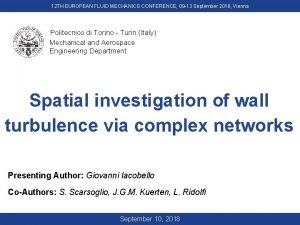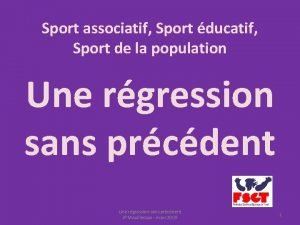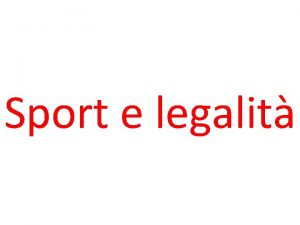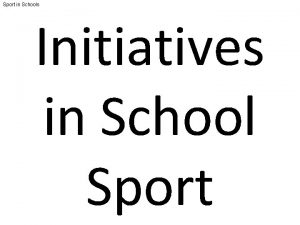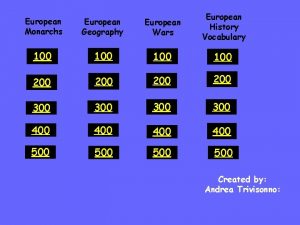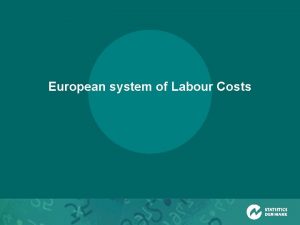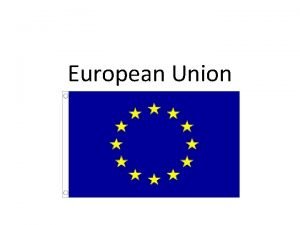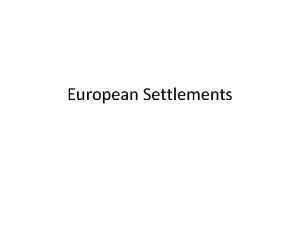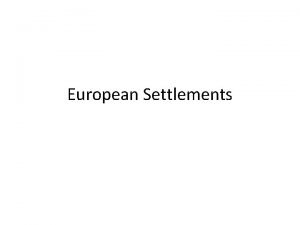The 8 th ESEA European Conference on Sport




















- Slides: 20

The 8 th ESEA European Conference on Sport Economics Demonopolization Perspectives in Russian Football: Experience of Krasnodar City Ksenia Andreeva, Ph. D candidate National Research University Higher School of Economics, Moscow

Plan • Basics of the research. The core issue • Concept of exclusivity • Football exclusivity in Europe • Optimal number of clubs in a city – Krasnodar experiment • Perspectives of demonopolization in Russia • New competitive policy • Discussion and feedback Two types of statements – propositions and proved results

Core issue • Krasnodar experience: the mean sum attendance was higher than the highest one in the league (in 2013/2014). It means that either football popularity has grown or supply has become sufficient • No changes in prices • Interest to derby • No correlation between attendance and its rivals results • Hypothesis of weak patient for a particular club – Yaroslavl (Shinnik and Lokomotiv) • Temporary policy – Lokomotiv Moscow in 2000 -2002. Higher attendance of the Saturn. Lokomotiv games than average; FC Tosno • Measures of regulatory policy and its limitations – no possibilities to increase popularity • Control supply (badminton) • Derby effect (B. Buraimo, R. Simmons, 2008) - 6. 4% increase of audience How does the number of clubs in the city influence consumers’ welfare and under what conditions does it positively influence the average attendance?

Exclusivity and sports monopoly Noll R. G. The organization of sports leagues (2003) • Three types of exclusivity: league, territory and club. Some countries develop institutional barriers to sustain territory exclusivity (USA) • Sheffield in England: United and Wednesday. Withdrawal from the market of one club does not influence the attendance of the second (should be checked for other cities like Birmingham)

Exclusivity and sports monopoly – 2 Breuer M. The demand for football tickets depending on the number of clubs in a city – Empirical evidence from Germany (2009) • two clubs playing in two different stadiums • wealth function depends on the utility of service of a particular quality minus travel costs: U(Ɵ 1) – t. D and U(Ɵ 2) – t(1 – D) – Hotelling model • if clubs play in different leagues, the indifferent consumer leaves in D-distance from the stadium: D* = (U(Ɵ 1) –U(Ɵ 2) )/2 t+1/2 • if clubs play in the same league, the indifferent consumer leaves in the center: D*= 1/2. • the empirical results show that in six German cities with two-club model from 1963 consumer preferences have not been changed due to the appearance of a rival club

Football exclusivity in Europe. Historical retrospective (stability from 1990 s) Three types of leagues: • Strong competition in the capital and several cities with 2 clubs (England, Sweden, Portugal) • A couple of cities with 2 clubs (Spain, Germany, Italy, Croatia , Belgium) • Non-competitive leagues within one city (France) • Occasional experiments*: Sweden, Russia (strong competition in the capital, 1 city with 2 clubs) Actually it means that there may be capital-oriented competition with at least 2 clubs in the capital (Austria, Azerbaijan), distributed competition (one or several regional cities with competitive clubs), non-competitive leagues and supercompetitive leagues. Exception – Rotterdam with 3 clubs * Experiment lasts less than 5 seasons

Football exclusivity in Europe. Inter-competition via intra-competition in Resource: List of top-division football clubs in UEFA countries 2016/2017 Germany England Austria Belgium Sweden Croatia Italy Netherlands Portugal Russia 2 alternatives Spain 3 alternatives 1 alternative multiple choice with competitive soccer club Sports for comparison: basketball, baseball, rugby, hockey, American football, baseball, handball, volleyball (team aggressive active sports)

Current results • There may be a followership for a particular type of sport • Does population matter? Strong competition may be both in the capital and small cities (Zagreb and Split, Leicester or Hull and London, Augsburg and Munich etc). Sometimes capitals compete for fans less than small cities (Bologna and Milan) • For many European cities football is the only sport to be presented in the highest league (the only reason for pride) Basically there are • Regional inter-sport countries (with more than 50% of cities with competed sports): Sweden, Russia, Spain, Italy – coincidence with previous classification • «Football countries» : Portugal (with almost no competition between sports), Belgium and Austria as a capital-centered sports country

An optimal number of clubs presented in a city •

An optimal number of clubs presented in a city-2 • (1, 1)

An optimal number of clubs presented in a city-3 • Who betters off? Clubs, fans, regional government… What influences the decision on the attendance? Is it among all the belongingness to a certain type of audience? Derby –segregation: • Economical: blue collars (Milan, Atletico, Sparta, Boca Juniors) and middle class or wealthy (Inter, Real, Slavia, River Plate) • Political views: nationalists (Barcelona) and monarchists (Espanol) • Distance from the center: city (Rome) and surroundings (Lazio) • Religion: Celtic and Rangers, etc. Not for all derbies – Manchester, Liverpool, Genoa, Lisbon And for Krasnodar?

Consumers’ behavior in Krasnodar •

What is a Krasnodar experiment about? • Redistribution effect – not the monopoly model • No competition between clubs – rival’s results do not influence (percentage difference between the fact and the ideal behavior) • If costs didn’t matter, the best strategy would be to visit games of both clubs

Perspectives for intra-city competition in Russia Clubs in 1 league from the competitive city Clubs in 1 league from non-competitive city Clubs in 2 leagues from the competitive cities Clubs in 2 leagues from non-competitive cities Clubs in 3 leagues from the competitive cities Clubs in 3 leagues from non-competitive cities We have 4 cities for potential internal competition (we do not take into account the second teams of the main one): • Makhachkala (Anzhi in the Premier League and FC Legion-Dynamo Makhachkala, founded in 2015, in the second league) • Saint-Petersburg (Zenit in the Premier League, Dynamo in the PFL) • Krasnodar (Krasnodar in the Premier League and Kuban in the FNL) • Rostov-na-donu (Rostov in the Premier League and SKA in the PFL) The only question is the resistance to constraints – but all are in the ½ in the GRP ranking

General regulatory policy Monopolization is sustained through the following instruments: • Licensing and fair play (no possibility for the aggressive market entrance) • Multidivisional approach (it takes 4 -5 years for the European club to play in the Premier league). Or even no rotation at the end of the season (USA) • Property rights • Limited number of clubs in the league (9 in Lithuania, 20 in Spain) - no correlation between population and number of clubs in general • Distribution of income etc.

Hypothetical map of the Russian Premier league in 2022/2023 • All 4 cities are represented by 2 clubs • Moscow is also presented by 2 clubs with the highest own attendance and the highest attendance of derby (now its Spartak and CSKA) • Lokomotiv Moscow moves to Bryansk (the light grey zone, according to the fans distribution, local stadium capacity, social structure) • Dynamo Moscow moves to Saransk • Let other clubs to be Terek, Tom, Rubin, Amkar

Wealfare model (The optimal size of a sports league (S. Kesenne, 2008)) •

Regulatory policy Instruments: • Tax reductions • Stadium sharing • Rankings – competitive index • Natural experiment • Smooth limits on foreign players Conditions: • Complicated social structure in the city • Zero transaction costs for clubs

Conclusions The directions of the future research are the following: • Regions – not cities • Audience criteria (especially in the inter-sport competition) • Updating classifications • Difference-in-difference modelling for all derbies of the same period • Modelling the structure changes and its consequences

Thank you for your attention. For any recommendations or suggestions please contact me via Andreeva. KA 1@yandex. ru
 Is esea safe
Is esea safe European fluid mechanics conference
European fluid mechanics conference Conference of european statisticians
Conference of european statisticians Vẽ hình chiếu đứng bằng cạnh của vật thể
Vẽ hình chiếu đứng bằng cạnh của vật thể Chụp tư thế worms-breton
Chụp tư thế worms-breton đại từ thay thế
đại từ thay thế Quá trình desamine hóa có thể tạo ra
Quá trình desamine hóa có thể tạo ra Sự nuôi và dạy con của hươu
Sự nuôi và dạy con của hươu Các châu lục và đại dương trên thế giới
Các châu lục và đại dương trên thế giới Các loại đột biến cấu trúc nhiễm sắc thể
Các loại đột biến cấu trúc nhiễm sắc thể Bổ thể
Bổ thể Biện pháp chống mỏi cơ
Biện pháp chống mỏi cơ Phản ứng thế ankan
Phản ứng thế ankan Thiếu nhi thế giới liên hoan
Thiếu nhi thế giới liên hoan Tia chieu sa te
Tia chieu sa te Alleluia hat len nguoi oi
Alleluia hat len nguoi oi điện thế nghỉ
điện thế nghỉ Một số thể thơ truyền thống
Một số thể thơ truyền thống Sơ đồ cơ thể người
Sơ đồ cơ thể người Cong thức tính động năng
Cong thức tính động năng Bảng số nguyên tố
Bảng số nguyên tố

